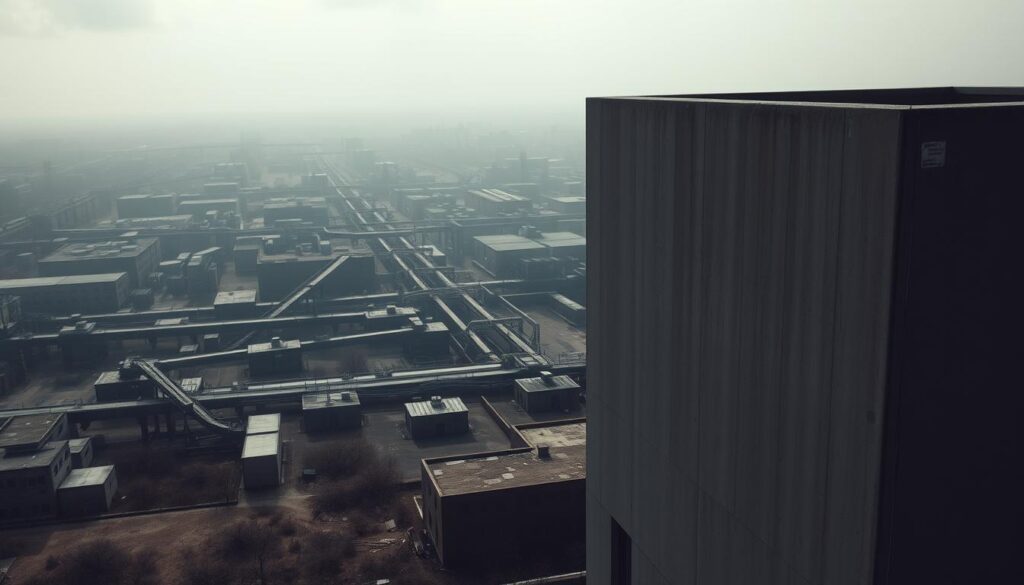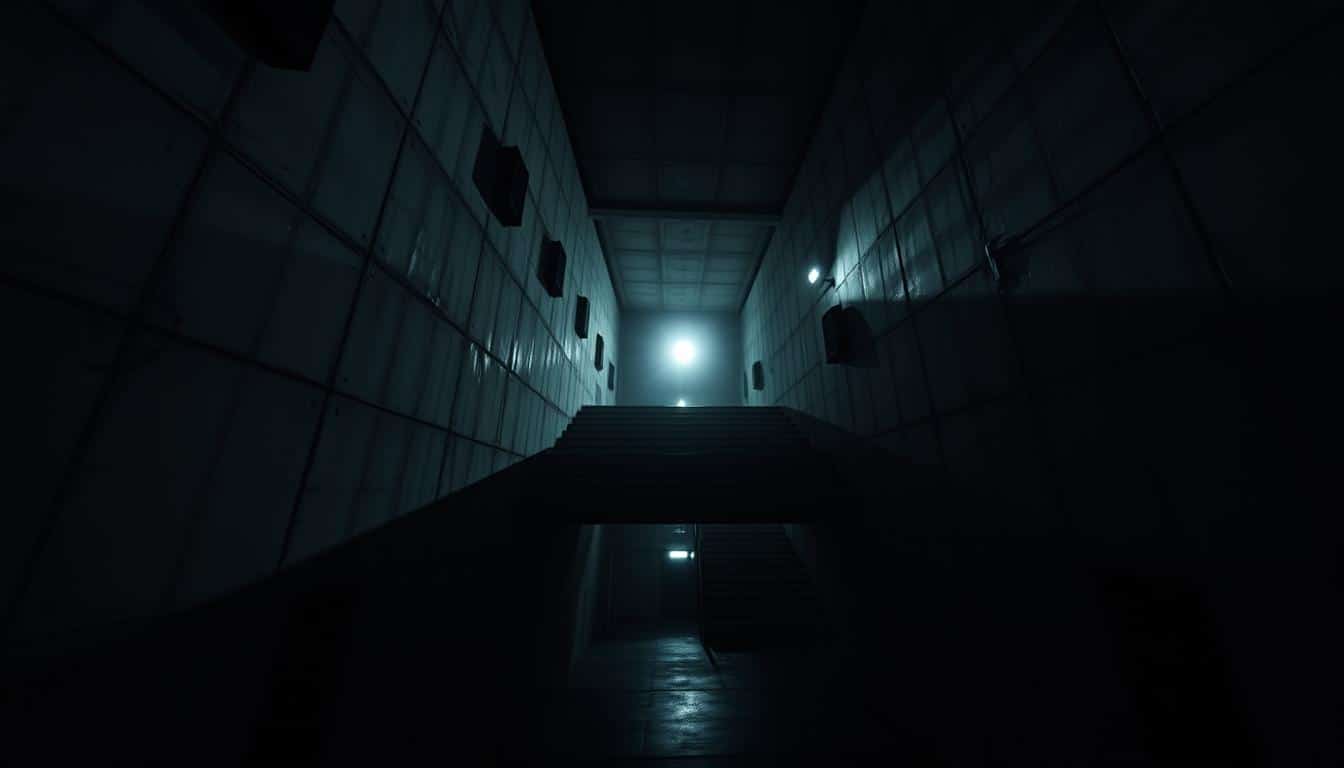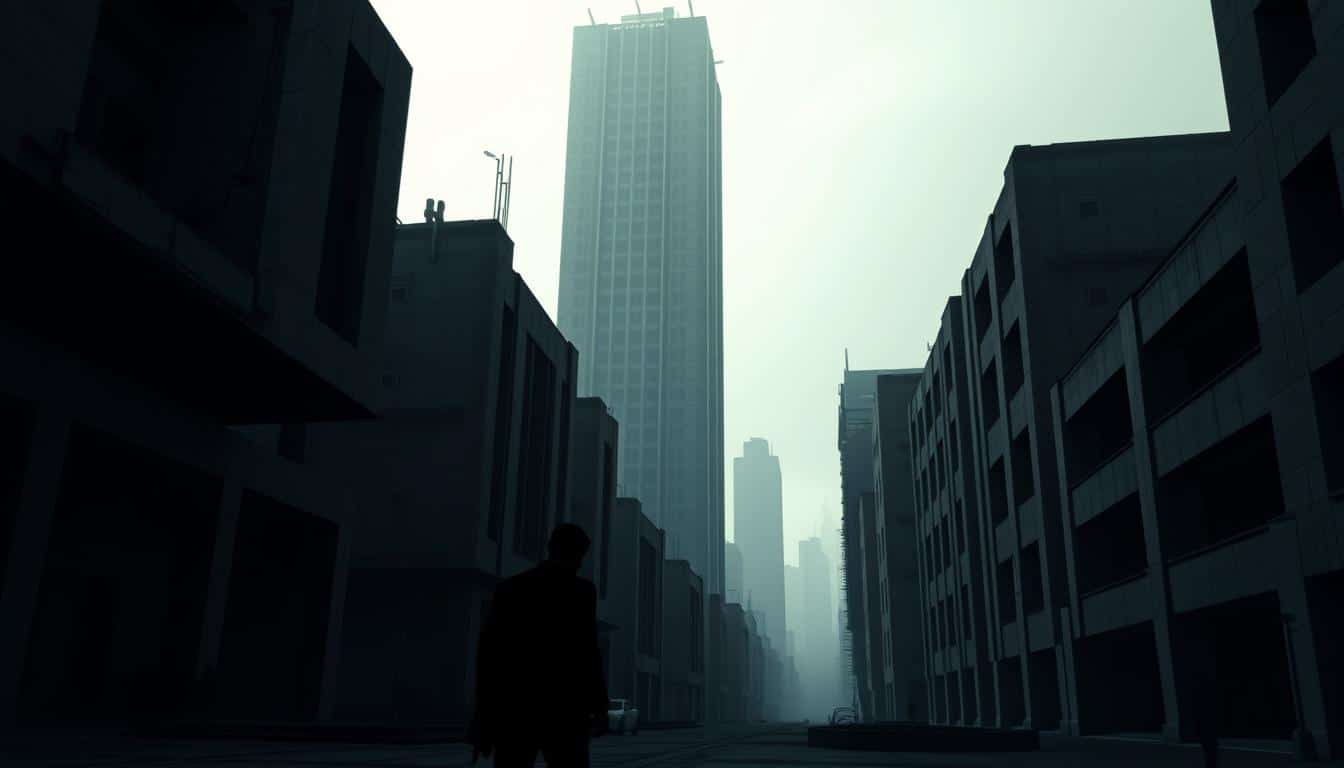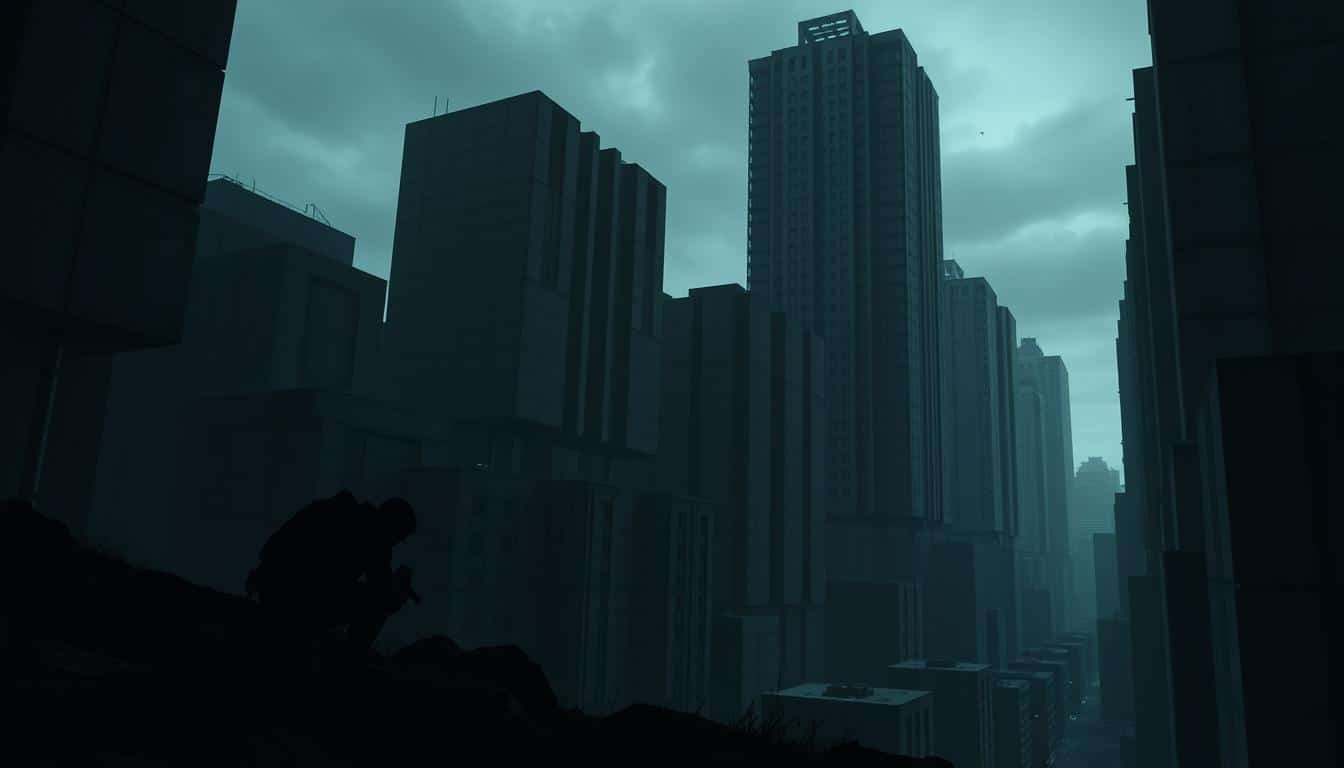The world of brutalism in gaming stands out as a big influence, especially in showing isolation. Its raw, big structures do more than just set the scene. They also push forward the story and feelings in games. Using brutalist designs, game creators make players feel alone and disconnected.
This style changes how players go through the game and how they feel about the story. We’ll look into how this design philosophy deeply affects gameplay and storytelling.
The Essence of Brutalism: A Brief Overview
Brutalism is about creating buildings with a bold, raw look. It features strong shapes, lots of concrete, and focuses on the building’s basic frame. This style is like telling the truth with architecture. It prefers simple, clear lines over fancy decorations.
In brutalism, less is more. Only the key materials and shapes stand out. This simplicity is meant to stir strong feelings. It connects people deeply with the buildings around them. Brutalism shows a culture that loves realness and straight talk in both art and buildings.

Historical Context of Brutalism in Architecture
Brutalism’s history is closely linked with post-war architecture changes. After World War II, European cities needed rebuilding to house many people. Brutalism, with its bold concrete and practical design, was the answer, supporting community spaces.
Architects chose brutalism to combine usefulness with impressive shapes. One key example is London’s Barbican Centre. It shows brutalism’s goals, offering housing and places for culture and fun.
Brutalism’s unique look led to discussions on its beauty and use. It made people think differently about city spaces. Today, brutalism’s impact shows how architecture tried to meet society’s needs through creative designs.
The Use of Brutalist Aesthetics in Gaming
Game designers are now using brutalist designs in games. They do this to bring out feelings of being alone and left behind. These designs are simple, using a lot of concrete and very few decorations.
This style helps make game worlds feel real and deep. Games with these designs often make us feel the loneliness of empty places.
Key elements of brutalist aesthetics include:
- Concrete textures that reflect a sense of rawness and reality
- Stark lighting that enhances shadows and creates dramatic contrasts
- Geometric shapes that contribute to a feeling of rigidity and simplicity
This style of design works well in games. It lets players feel a strong connection with the game world. It shows themes of cities falling apart and places nobody remembers.
As game designers try out these designs, how we experience games is changing. It adds more layers to the stories games tell.
Brutalist Structures as Symbols of Isolation in Gaming
Brutalist architecture shows us isolation in video games in a unique way. These large structures are more than just backgrounds – they’re part of the story. Players move through spaces that make them feel alone, echoing their character’s journey. The environment feels like it’s trapping and leaving them behind.
Examples of Isolation Through Design
Several games use brutalist settings to show loneliness:
- “Doom”: Cold, concrete halls make the danger feel empty and close.
- “Bioshock”: The underwater city of Rapture is creepy and lonely, with spooky visuals.
- “Control”: The Federal Bureau of Control’s big, maze-like building makes you feel stuck inside.
This way, games use their design to deeply show feelings of despair and being alone.
Player Interactions with Brutalist Environments
Interacting with brutalist game environments increases player control and deepens emotional reactions. As players explore these lonely places, they face their surroundings in new ways. Feeling isolated becomes a big part of the story. Some important aspects are:
- Puzzles that make you engage with the environment.
- Sounds that fill the game with emptiness and solitude.
- Few ways out, making the sense of being trapped stronger.
Such interactions make players feel a real connection to the game’s world. They show how important isolation is in game design. And they leave an impact that stays with players after they’re done playing.
The Emotional Impact of Ruins and Decay
The emotional pull of decay in video games deeply affects how players feel. Game makers use ruins to make worlds that deeply move people. When players see places falling apart, they feel a mix of sadness and intrigue.
How a game’s world feels can change how players connect with it. Seeing old buildings and wild, untamed nature can make players feel a sense of loss. This reaction makes the game’s story more gripping, encouraging players to dive deeper.
Decay in games can have many meanings. It can remind players of past events, adding layers to the game’s plot. By exploring these broken worlds, players face themes like being alone or forgotten. This makes the gaming experience richer and more impactful.
Case Studies: Iconic Games Featuring Brutalist Design
Brutalist architecture has left its stamp on the gaming industry, showing up in many famous brutalist games. These games use simple, geometric designs. They stand out by using visuals to share feelings of being alone and tense. Looking at games like “Doom” and “Half-Life,” we see how brutalist style makes the game feel deeper and affects how players feel.
The Influence of Titles Like “Doom” and “Half-Life”
“Doom” changed the first-person shooter game by using simple yet strong designs. It has gray concrete looks and tough spaces that fit with its survival theme. On the other hand, “Half-Life” takes brutalism further with big, industrial areas that make you feel stuck and alone. Both games are great examples of how “Doom” and “Half-Life” use stark buildings to make the game more engaging.
Societal Reflections in Gaming Landscapes
In recent years, video games have become deep platforms for cultural commentary. They use brutalist aesthetics to mirror societal concerns. These games show us urban experiences, highlighting the complexities of today’s life.
Players find themselves in environments filled with isolation, decay, and the essence of modern life. This prompts them to think about real-world issues.
Brutalism in games pairs stark architecture with dystopian stories. This combination creates a strong connection. Players explore urbanization and its socio-political challenges through these games.
These gaming landscapes often make players feel desolate. Yet, they also make them think about modernity’s impact on us, both individually and together. The use of gritty visuals serves as a way to examine societal issues.
When players venture into these worlds, they don’t just have fun. They are also prompted to think critically about important societal concerns. The reactions these games evoke highlight the significant role they play. They reflect the complexity of human experiences, sparking a discussion about real life outside the game.
How Brutalism Enhances Narrative Depth
Brutalist architecture adds powerful depth to video game stories. Its raw textures and big forms help create a game’s atmosphere. This sets the mood, making games more immersive and complex for players.
Creating Powerful Atmospheres
Brutalist elements often stir strong feelings, showing stark and tough worlds. They build a tension that makes players sense the environment’s impact. The use of concrete and big, open spaces explores themes like being alone and struggling to survive. This makes the game’s story deeper and moments of conflict more impactful.
Player Experience and Immersion Factors
Exploring brutalist places makes players feel more into the game. The big scale and challenges of these places shape the adventure. By mixing story and gameplay well, designers make engaging experiences that also add to the story. Every action and discovery adds to the overall story, with brutalism making the background even more compelling.
The Critique of Brutalism in Gaming
Games that use brutalism often face criticism. This style can limit player interaction. Its stark and plain look might push away players who want more immersive experiences.
The look of brutalism splits gamers. Some love its raw beauty, while others feel it’s cold and unwelcoming. This division affects how players explore and get involved in the game. If a game’s design focuses more on looks than use, storytelling may suffer.
Looking into brutalism in gaming shows how design affects player engagement. Knowing the limits of this style helps developers. They can find a good mix of art and fulfilling gameplay.
The Future of Brutalism in Game Design
The landscape of game design is always changing. Soon, brutalism could significantly shape this change. Developers might use brutalist ideas, mixing simple looks with deep gameplay. They’ll use brutalism to make games that deeply engage players.
New gaming looks will get a boost from better graphics and virtual reality. These tools will make the simple, bold lines of brutalism more intense. Players will explore spaces that are both big and interesting. The mix of simple design and high-tech graphics will be eye-catching.
Players now want games that feel real and meaningful. Brutalism could become more popular in game design because of this. Game makers could add brutalist styles to their stories, creating strong emotions. This mix could make players think more deeply about the game’s message.
The game industry might start combining brutalism with other styles. This mix could create new and exciting games. Games with brutalist designs could offer a fresh experience, where the style is part of the story.
To wrap up, brutalism has a bright future in game design. The blend of new tech and bold brutalist style will make games that challenge and excite players.
Conclusion
In summary, the design of brutalism in gaming deeply touches us. Game developers use brutalist designs not just as backgrounds. They use them as strong symbols of isolation. This makes players really think about their game worlds.
Design makes a big difference in memorable games. It lets us dig into stories and themes more. By using brutalism, developers add a lot of emotional depth to their stories. This makes game settings very powerful. They pull us in and make us feel strong things.
The gaming world is always moving forward. There are so many chances to try new things with brutalism in games. These stark game worlds teach us important lessons. They make us think about space, structure, and being alone. In gaming’s future, brutalist designs will shape how we experience stories and worlds in fresh ways.



